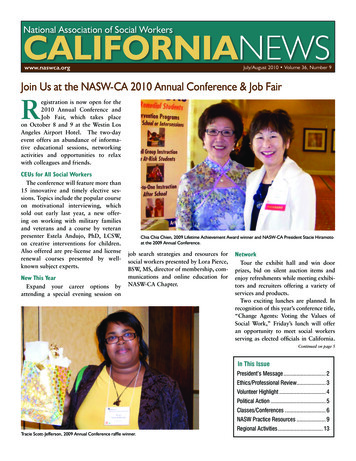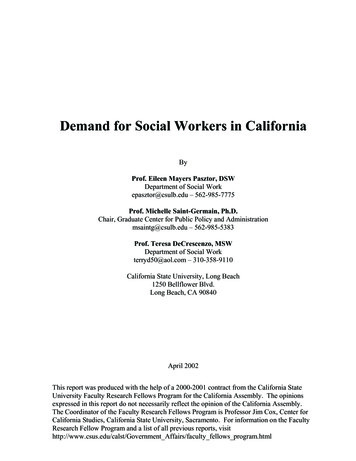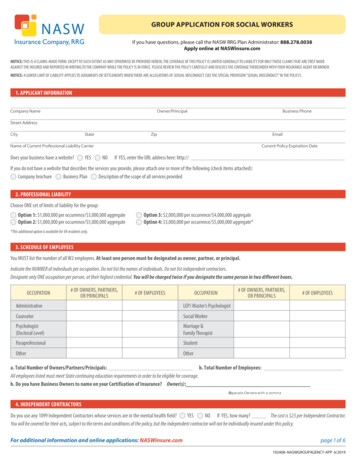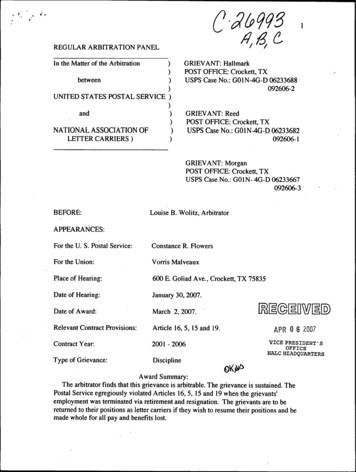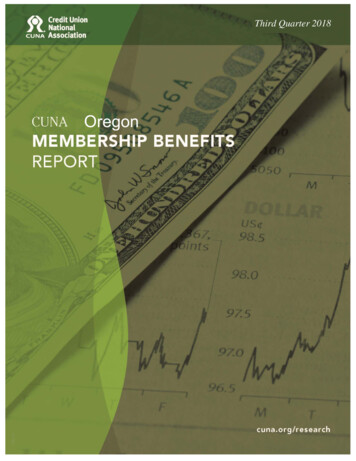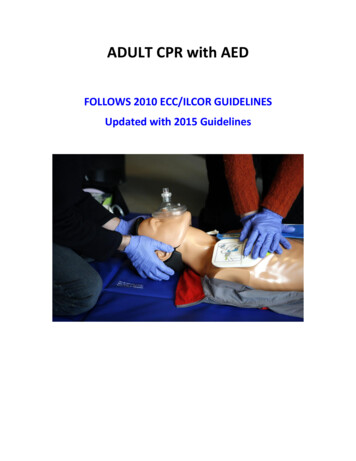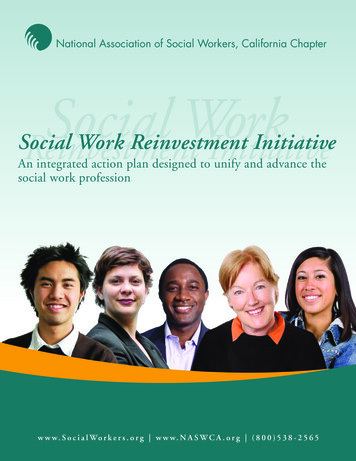
Transcription
National Association of Social Workers, California ChapterSocialWorkReinvestment InitiativeSocial Work Reinvestment InitiativeAn integrated action plan designed to unify and advance thesocial work professionw w w . S o c i a l Wo r k e r s . o r g w w w . N A S W C A . o r g ( 8 0 0 ) 5 3 8 - 2 5 6 5
The California Social Work Reinvestment Initiative (SWRI)IndexThe California SWRI INTRODUCTIONPages 3 - 14The Intent of the Social Work Reinvestment Initiative (SWRI)California Profile of Social Work Labor ForceCalifornia Social Work Education ProgramsCalifornia Demographic and Employment TrendsThe California SWRI PLANPages 15 - 24Legislative and Political Advocacy Goal and StrategiesPublic Education Goal and StrategiesWorkforce Development Goal and StrategiesStakeholder Engagement Goal and StrategiesPublic Education Campaign Ad SampleThe National Association of Social Workers - California Chapter1016 23rd Street, Sacramento, CA 95816Email: naswca@naswca.orgWebsite: http://www.naswca.orgPhone: (800) 538-2565Fax: (916) 442-20752
The California Social Work Reinvestment Initiative (SWRI)IntroductionThe Intent of the Social Work Reinvestment InitiativeA. The Intent of the NASW National and State Social Work Reinvestment Initiative (SWRI)In 2007, the NASW National office announced a major initiative designed to unify and advancethe social work profession at the state and national levels. The Social Work ReinvestmentInitiative is an integrated action plan that addresses four of the key goals identified by the 2005Social Work Congress and builds on the National Social Work Public Education Campaign andthe recent findings by the NASW Workforce Center.As explained by the National NASW Director, Elizabeth Clark, PhD, ACSW, MPH, “The goal is toget government, employers, and others to fully recognize the importance of social work and topersuade them to assist us in recruiting, retaining, and retraining professional social workers.”Work on the initiative will begin at the state level and may include components such as funding forsocial work education, support for research, strengthening policies and regulations to supportsocial work practice, and social work education loan forgiveness.Based on the guidelines provided by the National NASW SWRI Initiative, goals will be created forfour areas:Legislative and Political AdvocacyPublic EducationWorkforce DevelopmentStakeholder EngagementStrategies will be developed to accomplish the following:Recruit New Social WorkersRetain Current Social WorkersRetrain Experienced Social WorkersReactivate Community Investment in Social WorkB. The Process Utilized to Develop the California Social Work Reinvestment (SWRI) PlanCalifornia’s plan was based on a variety of social work education and practice issues, labormarket research and the Chapter’s 2006-2009 Strategic Plan. A Chapter Social WorkReinvestment Initiative (SWRI) Task Force was appointed to oversee its development.Beginning September 2007, the Chapter formally presented the preliminary Plan to numerousorganizations, associations, and groups (as listed below in Section C) along with its 12,000California NASW members to garner feedback in the form of suggestions and comments.The Chapter actively sought feedback until the Monday, December 10, 2007 deadline. Thefeedback received was reviewed and incorporated into the final document before being submittedto the California Board of Directors for their final approval and sent to the NASW National office.3
C. California’s SWRI Distribution ListOrganizationsAmerican Board of Examiners in Clinical Social WorkAmerican Society on AgingCalifornia Alliance of Child and Family ServicesCalifornia Association of Deans and Directors of Social Work ProgramsCalifornia Association of Black Social WorkersCalifornia Association of School Social WorkersCalifornia Board of Behavioral SciencesCalifornia Coalition for Ethical Mental Health CareCalifornia Council of Community Mental Health AgenciesCalifornia Department of AgingCalifornia Department of Health and Human ServicesCalifornia Department of Mental HealthCalifornia Department of Social ServicesCalifornia Family Resource AssociationCalifornia Institute for Mental HealthCalifornia Marriage and Family TherapistsCalifornia Mental Health Directors AssociationCalifornia Mental Health Planning CouncilCalifornia National Alliance on Mental HealthCalifornia Network of Mental Health ClientsCalifornia Psychiatric AssociationCalifornia Society of Clinical Social WorkCalifornia Social Work Education CenterCalifornia Youth ConnectionCounty Welfare Directors AssociationGlenn County Social ServicesHealth Association of Santa BarbaraLassen County Department of Social ServicesLos Angeles County Human and Social ServicesMental Health Association of San FranciscoOrange County Coalition for Mental HealthSan Diego County Coalition for Mental HealthSEIU Local 1021SLO County Welfare Director4
Organizations ContinuedWomen’s Health Policy CouncilYolo County Department of Social ServicesInternational Federation of Social WorkersAnnual Conferences and MeetingsAssociation of Black Social Workers Annual ConferenceCalifornia Board of Behavioral Sciences November Board MeetingCouncil on Social Work Education Annual MeetingCounty Welfare Directors Association ConferenceLatino Social Work Network Annual ConferenceSchool Social Work Annual ConferenceNational Association for Rights Protection and AdvocacyCalifornia Chapter Leaders and MembersThe Chapter’s SWRI Task ForceBoard of Directors: Officers, Regional Directors, and Student DirectorsThe California Delegates to the 2008 Delegate AssemblyCalifornia’s Ethics Committee MembersThe Chapter’s Regions and UnitsChapter CouncilsAsian Pacific Islander Council NorthAsian Pacific Islander Council SouthBay Area Social Workers in Healthcare CouncilJane Addams CouncilLong-Term Care Council NorthLong-Term Care Council SouthProgressive Social Work Practice and Education CouncilPilipino American Social Work CouncilRed Cross CouncilSocial Work Image CouncilWomen’s CouncilThe Chapter’s 12,000 Membership including students and affiliated groupsWebsiteInformation and document available on the Chapter’s HomepageCA NewsInformation published in the October, November, and December IssuesEmailInformation emailed bi-weekly in October and November Chapter updatesEventsInformation available during the October and November Chapter Events5
California Profile of Social Work Labor ForceA. Categories of Licensure in CaliforniaThere is only one social work license in California, the Licensed Clinical Social Worker (LCSW),which requires obtaining a MSW from a Council on Social Work Education (CSWE) accreditedschool of social work, gaining 3200 hours of post-masters clinical experience, fulfilling the prelicense coursework requirements, and passing two California specific examinations. This LCSWlicense allows the individual to perform independent and unsupervised psychotherapy. The LCSWlicense must be renewed every two years, and it is required that the licensee obtain thirty-six (36)continuing education units during each renewal period.Individuals with a BSW or MSW degree can be employed as social workers without holding astate license or certification. Despite the Chapter’s continued efforts to pass legislation providingtitle protection, currently there is no regulation requiring that those employed as “social workers”have a social work degrees.The California Board of Behavioral Science (BBS) StatisticsThese statistics were taken from the BBS website and were accurate as of September 2007.(a) Licensed Clinical Social Workers (LCSW)(b) Associate Clinical Social Workers (ACSW)16,6297,356 (MSWs pursuing a LCSW)B. The Board’s 2006 Demographic Survey ResultsLCSW Respondents: The Board reported a total of 7,556 LCSWs respondents. The LCSW respondents described their gender as:FemaleMale The LCSW respondents described their race and ethnicity as:Non-Hispanic WhiteHispanic LatinoMulti Race/OtherAsianAfrican AmericanAmerican Indian/Alaska NativePacific Islander e LCSW respondents described their language fluency (excluding English) %0.38%0.38%0.33%6
The LCSW respondents described their age (in years) as:MeanMedian The LCSW respondents described the number of years in practice as:MeanMedian 52.71 years54years20 years20 yearsThe LCSW respondents described their primary practice setting as:Private PracticeLicensed Health Care FacilityCounty/Municipal AgencyNon-Profit/CharitableOtherState/Federal AgencySchoolsCollege/University SettingNo 0%2.02%ACSW Respondents: The Board reported a total of 2,185 ACSWs respondents. The ACSW respondents described their gender as:FemaleMale The ACSW respondents described their race and ethnicity as:Non-Hispanic WhiteHispanic LatinoAsianAfrican AmericanMulti Race/OtherAmerican Indian/Alaska NativePacific Islander 24.30%2.88%1.56%1.10%0.78%The ACSW respondents described their age (in years) as:MeanMedian 49.89%22.01%11.21%7.92%6.32%1.14%1.05%The ACSW respondents described their language fluency (excluding English) as:SpanishChineseKoreanVietnameseTalalog 86.77%14.00%37.84 years34yearsThe ACSW respondents described the number of years in practice as:7
MeanMedian 5.9 years4 yearsThe ACSW respondents described their primary practice setting as:Non-Profit/CharitableCounty/Municipal AgencyLicensed Health Care FacilityState/Federal AgencySchoolsOtherPrivate PracticeCollege/University SettingNo %1.19%C. The BBS Website as a ResourceReaders are encouraged to visit the California Board of Behavioral Sciences (BBS) websitewww.bbs.ca.gov for more information regarding licensing requirements and guidelines, legislativeupdates, and up-to-date statistics. The Board recently revised and improved this website inresponse to feedback and suggestions.D. California’s Shortage of Social WorkersCalifornia has faced a shortage of LCSWs for several years and according to several studies,California will be faced with a greater shortage of social workers (BSWs, MSWs, and LCSWs) inthe future. As indicated in the “Master Plan for Social Work Education in the State of California”prepared by the California Association of Deans and Directors of Schools of Social Work and theCalifornia Social Work Education Center, California’s social worker shortage crosses all serviceareas including child welfare, mental health, developmental disabilities, and aging and adultprotective services.Factors that Increase the Demand for Social Workers in California Poverty is at 12.8%. Homelessness includes 361,000 persons on a daily basis. Mental illness means that approximately 595,500 individuals receive mental health servicesannually, reflecting a 100% increase since 1999. Illnesses and injuries—largely affecting children and the elderly—require health care services. Domestic violence affects 119,850 Californians annually. Child abuse and neglect constitute 21% of the nation’s child abuse and neglect referrals andapproximately 20% of the country’s foster care population resides in California. Elder abuse affects 250,000 Californians annually.Employment of social workers is expected to increase faster than average for all occupations through 2014.Social work is one of the occupations most affected by Baby Boomer retirements.From the Department of Labor/ Bureau of Labor Statistics8
California Social Work Education ProgramsA. BSW ProgramsCalifornia State University SystemCalifornia State University, ChicoCalifornia State University, FresnoCalifornia State University, Long BeachCalifornia State University, Los AngelesCalifornia State University, SacramentoCalifornia State University, San BernardinoHumboldt State UniversitySan Diego State UniversitySan Francisco State UniversitySan José State UniversityUniversity of California SystemUC BerkeleyUC Los AngelesPrivateAzusa Pacific University, AzusaLa Sierra University, RiversidePacific Union College, AngwinWhittier College, WhittierB. MSW ProgramsCalifornia State SystemCalifornia State University, BakersfieldCalifornia State University, ChicoCalifornia State University, Dominguez (Pending Candidacy)California State University, FresnoCalifornia State University, Fullerton (Pending Candidacy)California State University, NorthridgeCalifornia State University, East BayCalifornia State University, Long BeachCalifornia State University, Los Angeles9
California State University, SacramentoCalifornia State University, San BernardinoCalifornia State University, StanislausHumboldt State UniversitySan Francisco State UniversitySan Diego State UniversitySan Jose State UniversityUniversity of California SystemUniversity of California, BerkeleyUniversity of California, Los AngelesPrivateAzusa Pacific University, Azusa (Pending Candidacy)Loma Linda University, Loma LindaUniversity of Southern California, Los AngelesC. PhD or DSW ProgramsUniversity of California SystemUniversity of California, BerkeleyUniversity of California, Los AngelesPrivateLoma Linda University, Loma LindaUniversity of Southern California, Los AngelesD. California Social Work Program EnrolleesCalifornia State SystemAt any one time, approximately 1,500 students in the CSU system are studying toward the BSWdegree, and 2,000 toward becoming MSW social workers.University of California SystemApproximately 200 students are currently studying social work at the undergraduate level, 400students at the MSW programs, and 50 students at the PhD level.PrivateThe University of Southern California, Los Angeles enrolls an average of 600 MSW students and34 PhD candidates. At La Sierra University, there is an average of 70 students enrolled in theBSW program with 9-17 graduates per year. At Loma Linda University, there is an average of 102MSW students and 12 PhD students with 30-35 MSW students graduating yearly.10
E. California Social Work Program GraduatesIn 2004, the California Association of Deans and Directors of Schools of Social Work and theCalifornia Social Work Education Center developed the “Master Plan for Social Work Education in theState of California”. This plan determined the number of current degreed graduates (for all programs)and the need for future graduates based on demographic studies.DegreeCurrent GraduatesFuture Graduates NeededBSW300 per yearNeed 18,700 combined MSW and BSWMSW1,200 per yearNeed 18,700 combined MSW and BSWDSW30 per yearUndeterminedF. California Social Work Education Center (CalSWEC)CalSWEC is the nation's largest state coalition of social work educators and practitioners. It is aconsortium of the state's 18 accredited social work graduate schools, the 58 county departments ofsocial services and mental health, the California Department of Social Services and the CaliforniaChapter of the National Association of Social Workers.MissionIn June 1999, CalSWEC’s Board of Director’s met to reaffirm its commitment to a variety ofpublic human services in California and revised its mission statement to read:“The California Social Work Education Center is a partnership between the schools of socialwork, public human service agencies, and other related professional organizations thatfacilitates the integration of education and practice to assure effective, culturally competentservice delivery and leadership to the people of California.”Goals Recruiting and preparing a diverse group of social workers for careers in public humanservice, with special emphasis on child welfare; Defining and operationalizing a continuum of social work education and training; Engaging in research and evaluation of best practices in social work; Advocating for responsive social policies and appropriate resources; and Exploring other models and structures of operation that provide maximum opportunity foraccomplishing CalSWEC’s mission.Stipend ProgramsStipend programs are designed to meet the need for training more social workers in areas of specialconcern in California. The objective is to not only to increase the number of professionally qualifiedsocial workers in specific arena but also to develop a workforce that reflects the state’s diversity.Consequently, students are given a monetary award to pay for tuition, books, etc. in exchange foragreeing to work in the field for a specific period of time.11
Title IV-E Child Welfare Training and Stipend ProgramCalSWEC coordinates the Title IV-E Child Welfare Training Project and Regional TrainingAcademy (RTA) Coordination Project. In collaboration with its partners, it works to developpromising practices that enhance the effectiveness of child welfare services while alsosupporting and studying the retention of child welfare workers.California Mental Health Service Act StipendUsing the Title IV-model, this stipend was funded through the Mental Health Department and isadministered by CalSWEC. With the passing of the Mental Health Services Act (MHSA) in2004, there is an increased need for professionally trained mental health social workers andespecially for those who represent minority groups and who are bilingual.G. Recent Research Related to California’s Mental Health SystemReport: A Strategic Plan to Increase the Flow of Minority, Bilingual and Culturally CompetentProfessional Social Workers into California’s Mental Health System, September 2007“In July 2005, the School of Social Welfare at University of California, Berkeley received anaward from The California Endowment to develop a strategy to increase the flow of minority,bilingual and culturally competent professional social workers into California’s communitymental health system. This award funded a number of research initiatives that would allow theformulation of an overall strategy and a set of specific plan recommendations for enhancing therecruitment and retention of minority and bilingual students enrolled in Master of Social Work(M.S.W.) programs at California’s 17 graduate schools of social work.”The final report is based on a two-year study by the Center for Social Services Research,School of Social Welfare that involved an analysis of the existing literature into the recruitmentof minority and bilingual social work students, a series of focus groups and interviews withinformed respondents, and a documentary analysis of sources of financial aid available forsocial work students specializing in mental health. In Chapter 5: Action PlanRecommendations, there are seven major recommendations discussed in detail.To view the report, visit the Center for Social Services Research’s website athttp://cssr.berkeley.edu/12
California Demographic and Employment TrendsA. The 2000 Census StatisticsOne of the major issues in California is recruiting and retaining a culturally competent workforce thatreflects the racial and ethnic diversity of the populations to be served. To better understand thecurrent and potential labor market for social workers in California, the Chapter first reviewed the 2000Census Statistics related to age, race, languages spoken at home, and poverty status. This researchis important because California leads the nation in diversity and, as such, is challenged with asubstantial leadership role in designing and maintaining services that achieve cultural and linguisticcompetency. By 2040, the expectation is that the Hispanic/Latino population will grow to a 50%majority, while Whites will decrease to 26% and the percentage of Asians and Blacks will remainabout the same.The Chapter has been involved in partnerships with the California Deans and Directors of SocialWork Programs, the California Board of Behavioral Sciences, The California Association of MentalHealth Directors, and other organizations in looking at the current state demographics, potentialtrends, and related challenges to better understand how to recruit, prepare, and train social worker
which requires obtaining a MSW from a Council on Social Work Education (CSWE) accredited school of social work, gaining 3200 hours of post-masters clinical experience, fulfilling the pre- . Chico California State University, Fresno California State University, Long Beach
